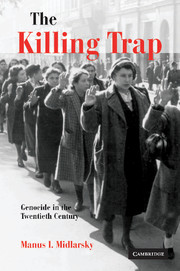Book contents
- Frontmatter
- Contents
- Preface
- PART I Introduction
- PART II Explaining perpetrators: theoretical foundations
- PART III The theory applied
- 6 Threat of numbers, realpolitik, and ethnic cleansing
- 7 Realpolitik and loss
- 8 The need for unity and altruistic punishment
- 9 Perpetrating states
- PART IV Victim vulnerability: explaining magnitude and manner of dying
- PART V Exceptions
- PART VI Conclusion
- References
- Index
6 - Threat of numbers, realpolitik, and ethnic cleansing
Published online by Cambridge University Press: 22 September 2009
- Frontmatter
- Contents
- Preface
- PART I Introduction
- PART II Explaining perpetrators: theoretical foundations
- PART III The theory applied
- 6 Threat of numbers, realpolitik, and ethnic cleansing
- 7 Realpolitik and loss
- 8 The need for unity and altruistic punishment
- 9 Perpetrating states
- PART IV Victim vulnerability: explaining magnitude and manner of dying
- PART V Exceptions
- PART VI Conclusion
- References
- Index
Summary
In this part, cynical and imprudent realpolitik are explored in their consequences for ethnic cleansing and genocide. Realpolitik alone as management of threats to the state (or preserving and strengthening the state) in whatever form will seldom, if ever, result in genocide. When constrained by loss, however, as suggested in the preceding chapter, the probability of genocide is vastly increased. Effectively, a single component of figure 5.1, the one with the most widespread political applicability, is now being examined, to be followed in the three succeeding chapters by an exploration of the entire model.
In this chapter, then, the consequences of realpolitik will be examined in three cases: the Irish famine of 1845–52, Polish ethnic cleansing policy of the interwar period, and ethnic cleansing in Bosnia with a genocidal incident embedded within it in 1995. I choose these cases because they are among the closest to genocide itself without reaching that level, thereby allowing for the possibility of one or two key variables distinguishing between ethnic cleansing and genocide. Certainly the accusation of genocide had been repeatedly leveled against the British as early as 1868 (see also chapter 17). At the local level, the Poles did engage in genocidal behavior during World War II, as at Jedwabne, discussed in chapter 1. And, to this day, Serbs have been accused of committing genocide in Bosnia.
- Type
- Chapter
- Information
- The Killing TrapGenocide in the Twentieth Century, pp. 113 - 134Publisher: Cambridge University PressPrint publication year: 2005



